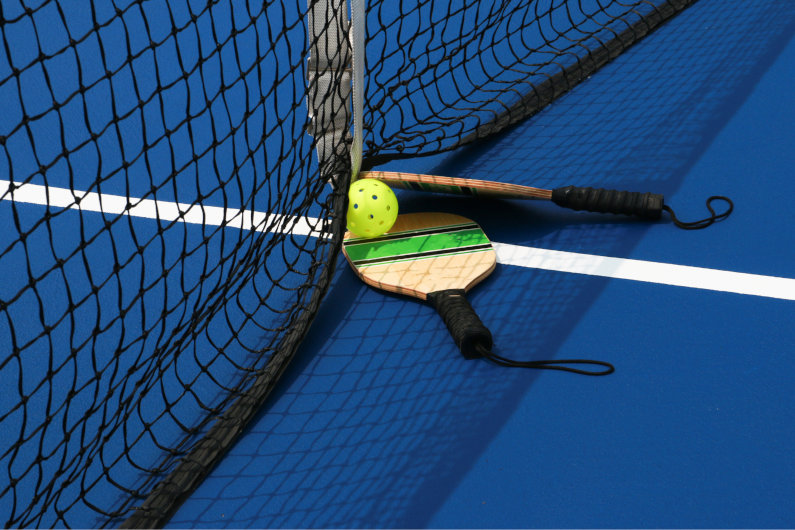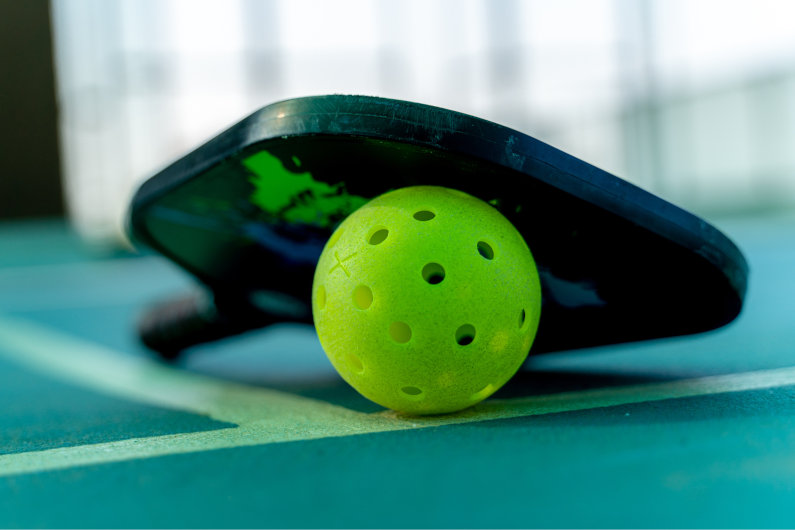Searching for pickleball courts near me?
An exciting new facility coming to Papillion, Nebraska!
Brace yourself for a thrilling new development in the Papillion community! In October, AEF Academy will open an indoor pickleball facility.

Maybe you’ve never played pickleball. It’s similar to ping pong and played on a smaller version of a tennis court. People often play it on outdoor courts with a paddle and balls. It’s a fast-growing sport and AEF Academy knew the Omaha Pickleball scene lacked courts in the area.
According to USA Pickleball, it’s the fastest-growing sport in America! The same can be said for the Omaha metro area, too!
Pickleball is a popular racket sport that combines elements of tennis, badminton, and ping-pong. It’s played on a small court with a net and is known for its fun and fast-paced nature. If you’re new to the game or have questions about the rules, you’ve come to the right place!
AEF Academy is the premier facility for Pickleball in the Omaha area and opening their pickleball courts in Papillion NE in October!
About AEF Academy’s Pickleball Courts
How many pickleball courts will AEF Academy have?
AEF Academy will have four regulation-sized pickleball courts in Papillion, Nebraska.
Will you have pickleball court rentals?
AEF Academy will offer pickleball court rentals from 8:00 – 3:00 p.m.
Will you offer pickleball leagues?
AEF Academy will offer pickleball leagues in the very near future. Check back for more details about pickleball leagues in the Omaha metro area.
Will you offer pickleball lessons, instruction, and coaching?
Yes, we will offer pickleball instruction in the very near future. Check back soon for more details about when pickleball leagues and instruction will begin in the Omaha metro area.
What are the dimensions of a Pickleball Court in Omaha?
Rising in popularity, this sport has people all over the world scrambling to learn more about pickleball courts. The game was created by Congressman Joel Pritchard, Barney McCallum, and Bill Bell in 1965 on Bainbridge Island, Massachusettes.
Nearly 60 years later, AEF Academy in Papillion, Nebraska is building off Pritchard’s work with their new indoor space.
AEF Academy is receiving repetitive questions, so we decided to address the frequently asked ones in order to provide answers.
What are the dimensions of a pickleball court?
Are pickleball courts the same size as tennis courts?
How do you measure and draw your own pickleball court lines?
Today we’ll cover the dimensions of a pickleball court and explain the boundary lines of pickleball courts.
We’ll also dive into how to measure and mark pickleball lines, so you can create your own pickleball court in minutes.
Given pickleball’s popularity, AEF Academy is meeting the needs of the Papillion community and starting with four pickleball courts.
What are the dimensions of a pickleball court?
The pickleball court dimensions are similar to a standard doubles badminton court. As per the regulations of the United States of America Pickleball Association (USAPA), the official size of a pickleball court is 20 feet (6.10 m) wide and 44 feet (13.41 m) long.
In this sport, the court size is the same for singles and doubles. The rulebook specifies the minimum play area as 30 ft wide by 60 ft long, including out-of-bounds areas.
To provide a sense of scale, four pickleball courts can fit inside one tennis court.

Handling Rules in Recreational Play
During recreational play, players may not strictly adhere to all the rules as having fun usually takes precedence over following them to the letter. For instance, the proper servers and receivers as specified in tournament rules may not be as important in casual games. However, it’s important to maintain good sportsmanship and make a conscious effort to stay within the rules.
Serve Hits the Net and Goes Over
When you hit the ball during a serve and it touches the net but still lands in your opponent’s service box, it is called a “let.” In this case, you get to serve again, and this can happen any number of times. However, if the ball lands outside your opponent’s service box or hits the kitchen line, it’s considered a fault.
The Rule on a Double Hit
Double hits in pickleball are legal if unintentional and part of a single stroke. Making another stroke or changing direction results in a fault.
Line Call Rules
Line calls can be a source of debate in pickleball. To be considered “in,” the ball must touch the paint of the line, regardless of whether it hovers above it. Line calls must be made promptly, and you only call shots on your side of the court. If there’s a dispute, you can ask your opponent or the referee.
Hitting the Ball with Your Hand
Hitting the ball with your hand is a fault unless you use your paddle. To make a legal shot, the ball must hit your wrist and the paddle’s end.
Rules on Player Behavior
Player behavior is usually respectful, but distractions can occur. Taunting is generally legal, but if someone distracts you right before you hit the ball, it’s a fault. We do not consider team communication and movement patterns as distractions.
Calling the Score
While technically you should call the score before serving, some players may not follow this rule closely in recreational play. It’s a good practice to know the score.
Using Two Paddles
You cannot use two paddles at the same time, but you can switch hands during play.
Ball Bounces Back Over
Even if a spinning ball comes back over the net, you can still hit it. You can hit the ball from the other side of the court. However, you cannot cross the plane of the net unless you intend to hit the ball.
Pre-Serve Routine
We encourage pre-serve routines as they help build confidence and muscle memory. You can bounce the ball with your hand as part of your routine.
Dead Ball
After a fault is declared, a dead ball indicates that the ball is no longer in play. Even if a ball is declared dead, other rules still apply.
Hitting a Ball That Bounced Out
You can hit a ball after it bounces out, but you must make the line call promptly afterward.
Hitting an Opponent with Your Serve
If your serve hits an opponent, you win the point, regardless of whether it was intentional.
Hitting Around the Net Post
You can hit shots around the net post, known as ATP shots, as long as you avoid hitting the net post itself.
Kitchen Rules for Dinking
You can be in the kitchen to dink a ball after it has bounced. The kitchen rule only applies when the ball hasn’t bounced.
Player Positioning
Player positioning before a point doesn’t matter except for the server. Receivers can stand anywhere on the court.
Tossing the Serve
There are no rules regarding how you should toss the ball when serving.
Ball Hitting the Portable Net’s Crossbar
If the ball hits the crossbar on your side of the net during play, it’s a fault. For a let, the ball must hit the crossbar after or before bouncing.
Hovering Paddle Over the Kitchen
You can hover your paddle over the kitchen; the kitchen refers to the physical ground, not the space above it.
Simultaneous Hits with Your Partner
Simultaneous hits where you and your partner hit paddles at the same time but one ends up hitting the ball are legal.
Scoring in Singles Play
In singles play, you’re the only server, and the server’s position depends on whether your score is even or odd.
Intentional Hitting of Players
While it’s not illegal to intentionally hit players, a referee can intervene and award points to the team being insulted if it’s considered malicious. Such situations are rare.
Dealing with Unfamiliar Rules
It’s important to be aware of unofficial rules made up by players. Familiarize yourself with official rules to avoid confusion.
We Look Forward to Seeing You on the Pickleball Court
We are excited for you to join the AEF Academy family! We are thrilled to introduce you to the exciting world of pickleball, volley zones, and Omaha Pickleball Courts!
We are looking forward to offering you pickleball leagues, court rentals, lessons, and coaching in Papillion Pickleball in the coming months.


